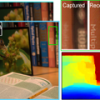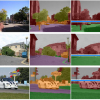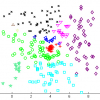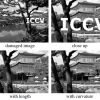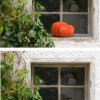ICCV
2009
IEEE
16 years 5 months ago
2009
IEEE
This purely theoretical work investigates the problem
of artificial singularities in camera self-calibration. Selfcalibration
allows one to upgrade a projective reconstruction
t...
98
Voted
ICCV
2009
IEEE
16 years 5 months ago
2009
IEEE
The classical approach to depth from defocus uses two
images taken with circular apertures of different sizes. We
show in this paper that the use of a circular aperture
severely...
103
click to vote
ICCV
2009
IEEE
16 years 5 months ago
2009
IEEE
High-level, or holistic, scene understanding involves
reasoning about objects, regions, and the 3D relationships
between them. This requires a representation above the
level of ...
ICCV
2009
IEEE
16 years 5 months ago
2009
IEEE
Prominent feature point descriptors such as SIFT and
SURF allow reliable real-time matching but at a compu-
tational cost that limits the number of points that can be
handled on...
ICCV
2009
IEEE
16 years 5 months ago
2009
IEEE
This paper is focused on the Co-segmentation problem
[1] – where the objective is to segment a similar object from
a pair of images. The background in the two images may be
ar...
ICCV
2009
IEEE
16 years 5 months ago
2009
IEEE
Object class models trained on hundreds or thousands of
images have shown to enable robust detection. Transferring
knowledge from such models to new object classes trained
from ...
112
click to vote
ICCV
2009
IEEE
16 years 5 months ago
2009
IEEE
Mean shift clustering is a powerful unsupervised data
analysis technique which does not require prior knowledge
of the number of clusters, and does not constrain the shape
of th...
ICCV
2009
IEEE
16 years 5 months ago
2009
IEEE
Image auto-annotation is an important open problem in
computer vision. For this task we propose TagProp, a discriminatively
trained nearest neighbor model. Tags of test
images a...
121
click to vote
ICCV
2009
IEEE
16 years 5 months ago
2009
IEEE
We consider a class of region-based energies for image
segmentation and inpainting which combine region integrals
with curvature regularity of the region boundary. To
minimize s...
113
click to vote
ICCV
2009
IEEE
16 years 5 months ago
2009
IEEE
Geometric rearrangement of images includes operations
such as image retargeting, inpainting, or object rearrangement.
Each such operation can be characterized by a shiftmap:
the...

